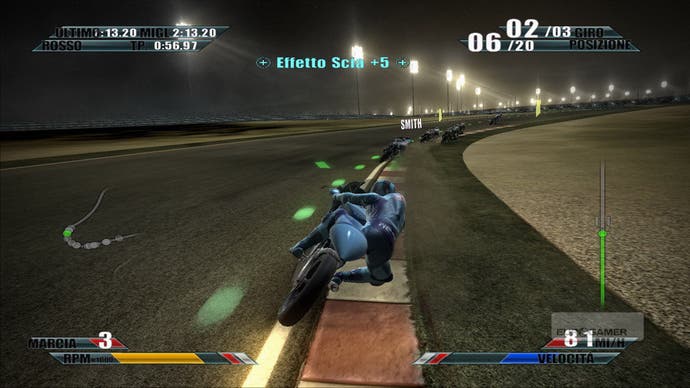MotoGP 09/10
Good but not the GOAT.
The current generation of MotoGP games hasn't had the smoothest of rides in terms of consistency and quality. After MotoGP '08, fans were left wondering whether Milestone would reprise its role for the 2009 season, but the Italian company went back to the Superbike World Championship instead. So as an alternative, Capcom opted for Monumental Games - a studio founded by ex-Climax employees - for the new MotoGP developer. But the question is, after two years in development, will Monumental finally be the one to do MotoGP justice?
In terms of handling simulation, hardcore racing fans may be disappointed, because MotoGP 09/10 is once again in the realms of arcade physics. Players can set the racing difficulty to gentle, moderate, severe or insane - as well as tinkering with traction control and front and back ABS - but even on the highest difficulty the riding experience is beyond forgiving. You can ride the 800cc bikes almost flat out along the long straight at Mugello at sub-180mph speeds, only to drop perfectly into the corner after barely a second of heavy braking.
It's also very difficult to crash, because even grabbing the front while at full tilt only results in rapid deceleration and a slight wobble - rather than the inevitable lowside. Furthermore, there's no visible feedback for gunning the throttle while the bike isn't more or less upright, as this should stutter the movement and harm your acceleration. The rear brake can also be used liberally while in the sweeping corners for subtle power-sliding, which is certainly possible, but it's not something the MotoGP elite use in every corner.

So it seems Monumental has crafted a riding experience that is unrealistic both in terms of how quickly the bike transitions from one state of movement to another and in the noticeable lack of punishment. These are 200bhp machines that are ridden to the very edge of stability, and 09/10 barely communicates the fleeting nature of traction. A prime example of this realism deficiency also struck home when I set a lap time of 1:22.82 with Capirossi on Philip Island. Not bad for a first attempt when you consider the real-life record is 1:30.059 - set by Nicky Hayden in 2008.
But while MotoGP 09/10 isn't all there in terms of biking simulation, it's nonetheless an accomplished arcade racing game. It's worth noting that I love motorbikes and games equally, but I've never been a big fan of when the two mix. Motorbike control is a pursuit that requires full feedback between body, bike and road, and there are far too many variables involved for the process to be effectively replicated on a control pad. But what Monumental has done is to make MotoGP into a "game", and one that is both playable and enjoyable.

The first port of call for most players will be the Championship mode, where you pick a rider from one of the three MotoGP racing classes and then race in the 17 (or 16) track season. As the upper classes start out locked you first have to pick someone like Scott Redding in 125cc, and then take him to at least third by the season finish - unlocking 250cc. As you'd expect the 125cc division is the least demanding, and to help players develop a better understanding of corner apexes the game also superimposes the optimum riding line in a similar style to the Forza Motorsport series. It can be switched off if you find it distracting.
The AI does a fairly good job of forming a rider pack, and depending on the set difficulty the opposition will either plod along steadily or make overtaking a real effort. Players who dislike fixed camera angles will also appreciate the option of camera tilt, although it would have been more useful if you could adjust it. This also goes for individual control setups, as even though the game offers 11 different configurations the lack of custom mapping is a baffling oversight.
That said, the default setup doesn't feel obtrusive, and for the fast play style it works effectively. On the 360 pad the throttle is on the right trigger and the front brake is on the left, whereas the left analogue stick is used for leaning and X sorts out the rear brake. Three different camera positions can also be selected and range from behind the screen - which is mildly disconcerting as you can't see the rider's hands - to a more typical camera that follows the rider, providing a better overview of the track.








